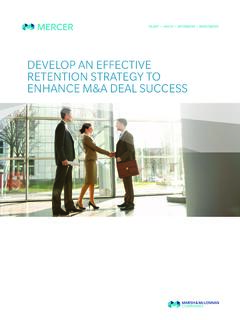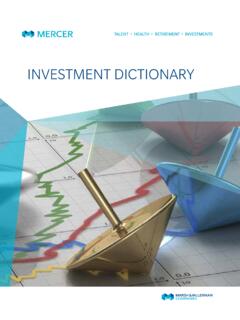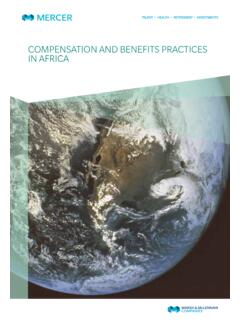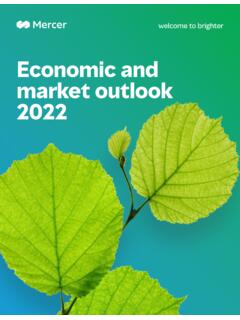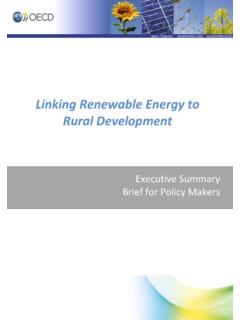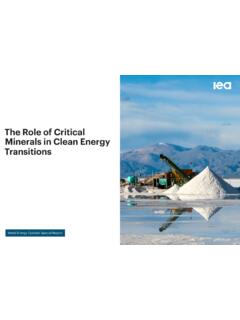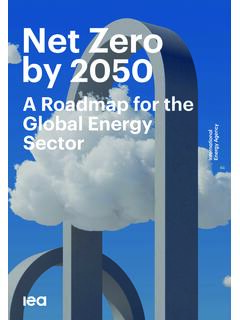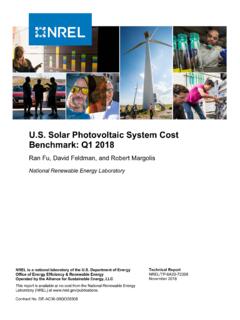Transcription of Infrastructure investing — A primer
1 Welcome to brighterInfrastructure investing A primerPrivate markets insightsPrivate markets Infrastructure investing A primer2 What is Infrastructure investing ? Infrastructure is an asset class that emerged in the mid-1990s and has continued to gain greater acceptance from institutional investors over time. The market is now over US$100 billion strong in terms of capital raised per year, with more than 100 funds closed Infrastructure is typically considered in a portfolio context alongside other private markets asset classes, such as private equity and real estate. However, Infrastructure investments share certain attributes that make them unique and are meant to provide steady, reliable returns across a wide variety of economic conditions.
2 Returns are generally inclusive of a cash yield, which is beneficial for investors who seek income as well as total is defined as the basic physical and organizational structures needed for the operation of a society or enterprise. Traditional Infrastructure subsectors include social Infrastructure (schools, hospitals, etc., typically built under public-private partnership frameworks), utilities (gas, water/waste and electricity networks), transportation (toll roads, airports and seaports) and energy Infrastructure (power generation and midstream assets, such as pipelines).1 Infrastructure Investor 2020 fundraising recently, newer subsectors within Infrastructure , such as digital Infrastructure (telecommunications towers, data centers and fiber optic networks) and energy transition Infrastructure ( renewable energy but also energy storage/efficiency), have become more mainstream.
3 The asset class continues to evolve, with certain logistics assets (such as food supply chains/cold storage, heavy goods vehicle trailers and short-line rail assets), healthcare and education businesses (for example, private hospitals and elderly care homes) and Infrastructure services businesses (such as industrial equipment leasing) also increasingly featuring within paper will primarily focus on private markets Infrastructure equity investing . However, investors should also be aware that it is possible to access the asset class through listed Infrastructure equity strategies and private markets Infrastructure debt strategies. As with any asset class, investors should first consider the strategic role of an investment within an overall portfolio is typically considered in a portfolio context alongside other private markets asset classes, such as private equity and real 2021 Mercer LLC.
4 All rights markets Infrastructure investing A primer3 Infrastructure risk and return categoriesCore Infrastructure This is considered the most stable form of Infrastructure equity investing , as these assets tend to be the most essential to society or otherwise largely de-risked (that is, brownfield in nature). Returns are generally derived from income with limited upside through capital gains, and assets are commonly held for the longer term (more than seven years). Revenues and cash flow are generally governed by either rate regulation, availability agreements (which provide for the payment of revenue as long as a facility is able to operate) or long-term contracts with highly creditworthy counterparties, such as governments, municipalities and top-tier industrial Infrastructure These assets have some similarities with core Infrastructure ; however, there is generally more variability associated with the cash flows of core-plus assets.
5 Income is still a component of overall returns, but there is also scope for greater capital appreciation. The holding period for core-plus assets is typically more than six years. Core-plus Infrastructure still primarily consists of brownfield assets. These assets are typically less monopolistic than core Infrastructure and may include a growth/GDP-linked component or some other form of asset or contract infrastructureThese investments typically include less monopolistic assets, assets that have a material growth, expansion or repositioning orientation, and certain greenfield assets. The holding period for value-add Infrastructure is generally shorter than for core-plus Infrastructure and typically ranges from five to seven years.
6 Returns are primarily from capital appreciation rather than ongoing Infrastructure These assets that have the highest degree of risk but also return potential. Assets can include those in development, those located in emerging markets, those subject to a high degree of volumetric or commodity price exposure, or those under financial distress and in need of significant repositioning. In general, opportunistic Infrastructure assets share many characteristics with private equity investments. Holding periods typically range from three to five years, and returns are almost entirely from capital Brownfield assets are those that are operating on a standalone basis or undergoing some form of expansion.
7 A greenfield project is a project under development and/or equity investing is typically divided into four main risk categories: core, core plus, value add and opportunistic. These are commonly accepted classifications used by investors to assist in portfolio construction and ensure appropriate diversification when allocating to the asset class. However, these classifications are also affected by factors such as an asset s development stage (that is, brownfield or greenfield2) and geography (that is, developed or emerging market ), among 2021 Mercer LLC. All rights markets Infrastructure investing A primer4 Key characteristics of each Infrastructure risk category are set out in Figure 1 profileTypical subsectorsTypical revenue driversManager net IRR targetsYield expectationImplied capital gain expectationHolding period (years)Core Gas, electric, water/waste and multi-utilities Contracted and renewable power generation PPP assets Mature, top-tier airports, seaports or toll roads in major markets Rate regulation Long-term contracts with governments or creditworthy counterparties (such as quasi-governmental entities)
8 Availability concessions with government agencies6% 9%5% 7%1% 2%7+Core plus Contracted thermal power generation Contracted renewable power generation with some development risk Contracted oil and gas midstream assets Toll roads, airports, seaports with greater GDP sensitivity Long-term contracts Concession arrangements subject to some volumetric/GDP-linked risk9% 12%4% 6%5% 6%6+Value add Greenfield assets under construction (de-risked to core plus once commissioned) Early stage oil and gas midstream Data centers and fiber optic networks Assets undergoing meaningful expansion Assets undergoing meaningful repositioning Long-term contracts on greenfield assets Short-term contracts Contracts with less creditworthy counterparties Revenues reliant on meaningful ramp-up through GDP or demographic growth12% 15%2% 3%10% 12%5 7 Opportunistic Infrastructure assets in developing markets Special situations.
9 Such as assets undergoing transition or financial distress Merchant power generation Merchant oil and gas midstream processing assets Traditional revenue profile but with meaningful exposure to both volume and pricing risk Likelihood of revenue volatility15%+0%15%+3 5 Figure 1. Infrastructure investment characteristics by risk profile Source: Mercer. Note: The Net IRR targets are consistent with return expectations set out by active Infrastructure investment managers and will therefore vary from Mercer s long-term capital markets assumptions. Actual returns will differ from expected returns, and the above are not meant to represent a guarantee of 2021 Mercer LLC.
10 All rights markets Infrastructure investing A primer5 Reasons for considering allocations to infrastructureThere are a number of reasons investors have been adding unlisted Infrastructure exposure to portfolios over the past decade. Some of the most important include:3 Morgan. Guide to Alternatives, as of August 31, 2020. Returns were calculated using quarterly data from June 30, 2008, to March 31, Correlation calculations have not been adjusted for the smoothing effect of lagged and estimated interim returns. Doing so could potentially result in different correlation and volatility Ibid01/ Intrinsic valueMany Infrastructure assets have intrinsic value.

